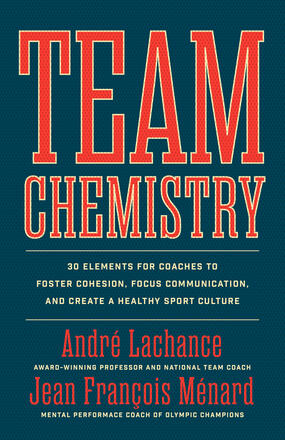
Team Chemistry
30 Elements for Coaches to Foster Cohesion, Strengthen Communication Skills, and Create a Healthy Sport Culture
Description
Explores what is needed to foster a healthy culture—the common element in winning teams—and provides coaches and sports administrators, at all levels, with action plans for developing a positive environment that brings out the best in athletes and supports in-game success.
Reviews
“To become the best decathlete in the world, you must surround yourself with coaches who think outside the box and who are ready to do things differently. If you don’t, chances are, you will end up like your competitors. This book is all about that; it dives into concepts beyond traditional coaching methods. Team Chemistry represents very well how my coaches operate: keep an open mind, challenge the status quo and get creative to find a competitive edge.” — Damian Warner, Decathlete, 2020 Olympic Gold Medallist
“Sport leaders play such an important role to ensure team success. My favourite coaches weren’t only great technicians and tacticians; they communicated clearly, instilled confidence and cared about the players. Team Chemistry will be a valuable part of a coach’s toolkit.” — Laurent Duvernay-Tardif, guard, New York Jets, Super Bowl LIV champion
“Lachance and Ménard show us that building team chemistry one athlete, one staff member, one practice, and one day at a time is about more than just the results on the scoreboard. It is a skill that coaches at any level can learn and their book provides the tools to do so. Team Chemistry will become a trusted resource for coaches in every sport.” — Danielle Goyette, three-time Olympian, eight-time World Champion, Player and Coach, HHOF 2017
“I have been fortunate enough to work with and observe many talented coaches, the vast majority of them possessing great content knowledge and ability to teach their craft. However, the highly successful coaches were the ones who also invested their time and bandwidth in building a truly superior culture. Team Chemistry provides the tools and techniques to help sport leaders foster an elite culture, a culture of respect and responsibility that will in turn help players and staff reach their optimal performance. A terrific book that both aspiring and veteran coaches should read and put to use.” — Kai Correa, Coach, San Francisco Giants, MLB
“Creating a healthy culture goes hand in hand with developing how you play, your tactics and strategies, and might even be the most important part of a coach’s job. Just like the players we work with, coaches can always improve. Team Chemistry enhanced my thinking in this space and provided me with new ideas for creating the best environment for my players, my staff, and myself.” — Bev Priestman, Head Coach, Team Canada Women’s Soccer, 2020 Olympic Gold Medallist